Do-it-yourself Injection Gas Burner: Blacksmithing Manual
The principle of operation of the injection burner for small forges is based on the suction of a gas stream into the burner body. You can buy it in the store. However, if a do-it-yourself gas injection burner is made for the furnace, it will serve no worse.
We will talk about how to build a tool in accordance with all the rules. The main thing is to take into account all the requirements in the manufacture. After all, you still have to deal with an explosive mixture of gas and air.
The content of the article:
Characteristics and types of injection burners
The degree of burning of the metal when it is heated for forging, the rate of formation of scale on the surface, and the total gas consumption depend on the execution of the burner. In closed forges, short-flame burners are used.
Their design ensures rapid mixing of the combustible mixture, which ensures high efficiency. The products of combustion from the working space of the furnace are removed uniformly and as efficiently as possible.
Burner principle
In burners of this type, propane coming from a gas pipeline or cylinder is burned. Here, a mixture of gas with air is formed due to ejection, i.e. suctioning the latter into the burner under the influence of the energy of a gas jet under pressure.
In the zone where the air intake takes place, a vacuum appears, due to which the air itself moves in a given direction. Mixing in the burner body, the working mixture breaks out of it under pressure, creating the desired temperature.
Quality of work gas burner depends on the constancy of the ratio of the volume of gas and air. A change in gas density affects the possibility of air being drawn in by the burner.
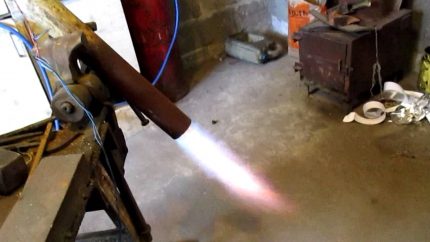
All changes in combustion temperature must be accompanied by similar changes in the air supply required for ignition.
If the indicators are unbalanced, an adjustment of the injection coefficient is necessary to achieve its stability. This is achieved by changing the gas pressure or by adjusting the air damper.
Classification of burners by main features
They are classified according to various criteria. Based on the volume of primary air sucked in, burners are distinguished for partial mixing and full. The main characteristics of the former are injection coefficient and multiplicity.
The injection coefficient is determined by the ratio of the volumes of air injected and gas required for 100 percent combustion. By the expression "injection ratio" is meant the ratio between the volume of primary air and the gas consumption of the burner.

Injection burners used in home forges come in low (up to 5 kPa) gas pressure and average pressure from 5 kPa to 0.3 MPa. When the gas in the burner is at a pressure of 20-90 kPa, the air suction power remains almost unchanged, even when the gas pressure and vacuum undergo changes in the furnace.
When the pressure drops below this bar, the injection coefficient rises, the pressure drops, and the vacuum in the furnace increases. Depending on the availability of the distribution manifold, there are single and multi-torch burners.
There is a separation according to the number of nozzles: with one nozzle - single-nozzle, with several - multi-nozzle. Place these elements in the center or in a spread. On this basis, there are burners with a central nozzle and peripheral.
Homemade Injection Burner
To a home-made burner of a standard design, gas is supplied from the cylinder through a special hose, usually propane. There is no need for a reduction gearbox, since the gas supply is regulated by a working valve located on the cylinder.
Opening and closing the gas supply is carried out using a shut-off valve, the rest of the burner adjustment is carried out by means of a working valve. Gas hose, through which the gas flows, is connected to a special nozzle with a nipple.
This allows you to set the magnitude and speed of the flame. The nipple and tube are placed in a metal cup. Here, propane is saturated with oxygen from the incoming air.

From a metal cup, the combustible mixture enters the combustion zone through a nozzle under pressure. In order for the process to be continuous, there are special holes in the nozzle that play the role of additional ventilation.
For self-production, you will need a drawing of a gas burner for a hearth, as well as a set of tools and materials:
- pieces of pipes, hardware;
- Bulgarian;
- semicircular or round file;
- the drilling machine, if not, can be replaced with a drill;
- semi-automatic welding;
- tap, lerka, drill, metal brush, hammer, pliers;
- circles - stripping, cutting;
- iron sheet 1.2, 3 mm thick;
- protective equipment for welding.
All work on the manufacture of a fuel burning device consists of five stages.
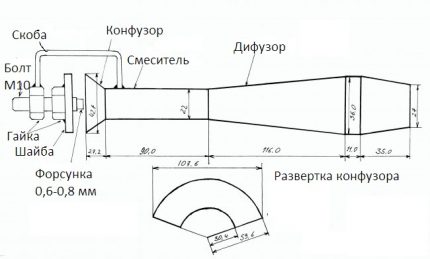
At the first stage, a diffuser is made. As a starting material for it, you can take a pipe segment of a suitable diameter. For example, a stainless steel silencer or a water pipe.
Along the pipe with a grinder make cuts to the desired length. A sleeve from a bearing with a suitable diameter is stuffed onto the tube.The same thing is repeated on the other hand.
The saw cuts are brewed, then they take a blade of petals and process the surface until smooth. Brew and clean all available pores and not boiled areas. Using a round or semicircular file, the burrs are removed inside the part.
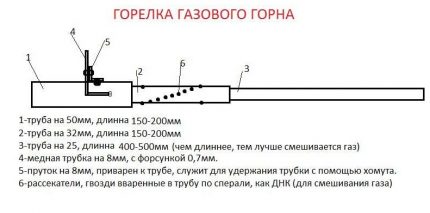
The next step is the manufacture of a mixer and confuser. The first is a tube. A water pipe with a diameter of about 2 cm, a length of 9 cm is suitable. The tube is welded to the diffuser, and the confuser to it is a cone for air intake.
A blank for it can be cut out from a sheet 1.2 mm thick. Then it is bent, the seam is welded and the finished part is welded to the mixer. From the end they make a plane for adjoining the adjusting washer. By reducing / increasing the gap between the confuser and the washer, the incoming air flow is adjusted.
Then proceed to the manufacture of a mechanism for supplying components of a gas-air mixture. At this stage, you will need a bolt with a long M10 thread. The hat is cut off, then a through hole of 5 mm diameter is drilled from the end, the M6 thread is cut.
To create a nozzle, you can use the tip to sum the welding wire from a semiautomatic device. Since it has a decent length, it needs to be trimmed. In this case, approximately 3-4 mm should remain after the thread. The remaining part is enough to make another nozzle.
For further work, a washer with an outer diameter of 43 mm will be required. It can be purchased or made independently from a sheet of metal. A hole with a diameter of 1.2 cm is drilled in the center of the washer. An M10 nut is welded to the finished washer.
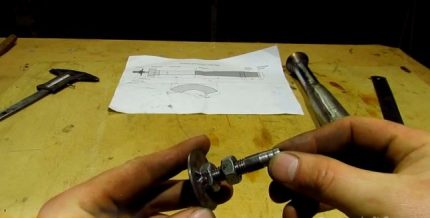
Before proceeding with the installation, it is necessary to mount the unit to the body in the form of a bracket. It can be cut out of sheet metal. Without changing the position of the assembly, apply it to the confuser, attach the bracket and weld to the nut and body. The place of welding is not very important, but it is necessary that the structure is rigid.
Screwing and unscrewing the bolt, regulate the degree of ejection. As practice shows, the optimal result is achieved when the nozzle enters the confuser to a depth of about two mm. The amount of incoming air is regulated by a washer.
The final step is the test. To do this, put a hose on the bolt. A pressure indicator of 0.2 kg / cm² is set on the gearbox. You can experiment with this value, but you need to remember that with a large gas flow rate, a cylinder, especially with a capacity of 5 l, can quickly freeze. In this case, a nozzle of 0.6 mm is more suitable.
The washer must be closed completely before ignition or a small gap should be left. After igniting the gas, the air supply is gradually increased. The flame will acquire an increasingly saturated blue color and gradually move away from the nozzle of the burner. A feature of the operation of the burner in an open hearth is that with further amplification of the air stream, the flame separates from the burner and its attenuation occurs.
To avoid such a phenomenon, an obstacle (divider) is placed along the flame path or the burner is used in an enclosed space. In this case, the fire escaping from the nozzle will ignite the gas and combustion will be maintained.

If the burner is powered by main gas, then under ideal conditions its flame should be bright blue.When the gas source is a cylinder filled with a propane-butane mixture, the fuel mixture has the appearance of yellow tongues.
Such an injection type burner works perfectly in confined spaces. If you adjust it well, you can get a temperature of up to 1200⁰. These conditions are suitable for forging blanks from files, annealing blades, and smelting non-ferrous metals.
They supply gas to the burner from the mains or cylinder, and the process is controlled by the regulator. To check the adjustment and pressure, a test run of gas or gas mixturewhile monitoring the smell.
Pros and cons of an injection burner
The use of a quality gas burner for blacksmith forge has several advantages:
- the use of gas energy for air injection;
- good mixing of air with gas;
- the ability to control the volumetric ratio of gas / air when changing the temperature of the burner;
- ease of use;
- profitability;
- simplicity of design.
Backgammon with advantages there are some disadvantages. Single nozzle burners, taking into account the thermal power, are quite long. It is necessary to ensure strict coincidence of the axis of the nozzle and burner. They make a lot of noise during operation.
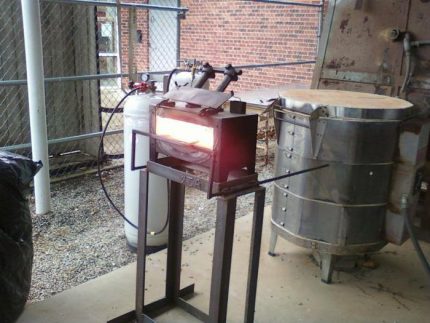
Significant disadvantages of low pressure burners are the large length of the torch, as well as the dependence of the secondary air supply rate on the furnace liquefaction.
Introduces varieties of gas burners for bath stoves and methods of their installation next article, which is worth reading to all owners of suburban areas with their own bathhouses.
Conclusions and useful video on the topic
The injection burner developed by Alexander Kuznetsov is especially popular. In this video, he talks about what the structure consists of and how to assemble it:
An example of an injection burner:
Properly designed and made with your own hands exactly to the requirements, the injection burner will become a reliable assistant for a long time. This device will replace expensive factory-made tools. With its help, you can solve many everyday problems without resorting to the help of professionals.
Want to talk about how to assemble an injection torch for blacksmithing with your own hands? Do you have useful information on the topic of the article? please leave comments in the block form below, ask questions, post photographs.

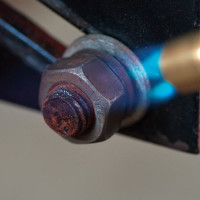 DIY gas torch from a blowtorch: a manual for the manufacture and operation
DIY gas torch from a blowtorch: a manual for the manufacture and operation  DIY propane gas burner: step-by-step instructions for assembling home-made burners
DIY propane gas burner: step-by-step instructions for assembling home-made burners  Do-it-yourself gas burner for a sauna stove: how to make a home-made device
Do-it-yourself gas burner for a sauna stove: how to make a home-made device  DIY gas stove: the best options for homemade tiles from improvised materials
DIY gas stove: the best options for homemade tiles from improvised materials 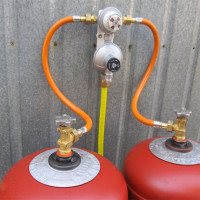 Gas cylinder ramp: device + DIY manufacturing example
Gas cylinder ramp: device + DIY manufacturing example 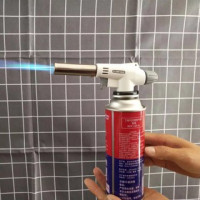 Do-it-yourself marching gas burner repair with piezo ignition: common breakdowns and their elimination
Do-it-yourself marching gas burner repair with piezo ignition: common breakdowns and their elimination  How much does it cost to connect gas to a private house: the price of organizing gas supply
How much does it cost to connect gas to a private house: the price of organizing gas supply  The best washing machines with dryer: model rating and customer tips
The best washing machines with dryer: model rating and customer tips  What is the color temperature of light and the nuances of choosing the temperature of the lamps to suit your needs
What is the color temperature of light and the nuances of choosing the temperature of the lamps to suit your needs  Replacement of a geyser in an apartment: replacement paperwork + basic norms and requirements
Replacement of a geyser in an apartment: replacement paperwork + basic norms and requirements